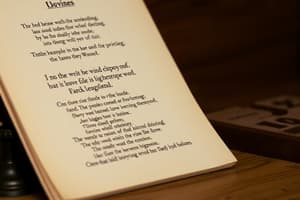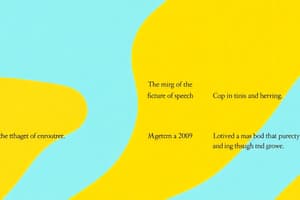Podcast
Questions and Answers
Which poetic device involves the omission of conjunctions between words, phrases, or clauses?
Which poetic device involves the omission of conjunctions between words, phrases, or clauses?
- Alliteration
- Anaphora
- Assonance
- Asyndeton (correct)
How does Shakespeare use language to enhance the emotional impact of Romeo and Juliet?
How does Shakespeare use language to enhance the emotional impact of Romeo and Juliet?
- By using complex legal jargon to highlight the societal laws.
- Using direct and literal language to avoid ambiguity.
- With metaphors, similes, and poetry to express deep emotions. (correct)
- Through simple prose to ensure the audience understands the plot easily.
What is the most accurate description of the 'theme' of a stage play?
What is the most accurate description of the 'theme' of a stage play?
- It represents the specific instructions for actors and stage crew.
- It's the central idea or underlying message that the story revolves around. (correct)
- It encompasses the sequence of events with a beginning, middle, and end.
- It is the conversation between characters in the play.
In the context of Twenty Thousand Leagues Under the Sea, what does the ocean primarily symbolize?
In the context of Twenty Thousand Leagues Under the Sea, what does the ocean primarily symbolize?
In Romeo and Juliet, how does the use of light and dark imagery affect dramatic tension?
In Romeo and Juliet, how does the use of light and dark imagery affect dramatic tension?
Which of the following is the best example of an oxymoron?
Which of the following is the best example of an oxymoron?
What is the primary function of 'stage directions' in a play script?
What is the primary function of 'stage directions' in a play script?
What can be inferred about the character Kurt, based on the following scenario: 'Bill and Jessica were almost done taking turns to choose the players for their teams. It was Jessica's turn to choose, and only Kurt was left. Jessica said, 'Kurt.'
What can be inferred about the character Kurt, based on the following scenario: 'Bill and Jessica were almost done taking turns to choose the players for their teams. It was Jessica's turn to choose, and only Kurt was left. Jessica said, 'Kurt.'
How do stanzas function within a poem?
How do stanzas function within a poem?
In Romeo and Juliet, what role does miscommunication play in the tragic outcome of the play?
In Romeo and Juliet, what role does miscommunication play in the tragic outcome of the play?
Flashcards
Poetry
Poetry
A type of literature using sounds, rhythms, and word meanings to describe the world imaginatively.
Line (in poetry)
Line (in poetry)
A single line in a poem; similar to a sentence but without the requirement for periods.
Stanza
Stanza
A group of lines in a poem, similar to a paragraph in prose, separated by a skipped line.
Rhyme
Rhyme
Signup and view all the flashcards
Rhyming Scheme
Rhyming Scheme
Signup and view all the flashcards
Simile
Simile
Signup and view all the flashcards
Metaphor
Metaphor
Signup and view all the flashcards
Personification
Personification
Signup and view all the flashcards
Alliteration
Alliteration
Signup and view all the flashcards
Oxymoron
Oxymoron
Signup and view all the flashcards
Study Notes
- Poetry uses sounds, rhythms, and word meanings to describe the world in striking and imaginative ways.
Basic Elements of a Poem
- A line in poetry is similar to a sentence but doesn't require periods.
- Stanzas are the poetic equivalent of paragraphs, grouping lines together and separating them with a skipped line.
- Rhyme is the repetition of similar sounds, included in many but not all poems.
- Rhyming scheme refers to the rhyming pattern within a poem.
- Rhyme schemes can include words that rhyme in every line or alternating lines.
- Rhyme schemes are signified using an arrangement of letters.
Commonly Used Poetic Devices
- Simile: comparing two things using "like" or "as".
- Metaphor: comparing two things without using "like" or "as".
- Personification: giving human qualities to non-human objects or things.
- Alliteration: repetition of two or more of the same sounds at the beginning of words in a line.
- Anaphora: repeating words at the start of two or more consecutive lines.
- Assonance: repetition of vowel sounds within lines.
- Asyndeton: a style omitting conjunctions between words, phrases, or clauses.
- Oxymoron: a figure of speech pairing two contradictory terms or ideas to reveal a deeper truth.
- Onomatopoeia: creating sounds in a poem.
- Repetition: using a phrase or line multiple times within a poem.
Making Inferences
- The process of making a conclusion based on prior knowledge, evidence, and experience.
- It goes beyond the text to make a judgement about what is not explicitly stated.
Elements of a Stage Play
- Theme: The central idea or underlying message of the play.
- Characters: The entities portrayed in the play, brought to life by actors.
- Plot: The sequence of events and actions that happen in a play, including exposition, rising action, climax, falling action, and resolution.
- Dialogue: Spoken word exchange between characters, including monologues
- Stage directions: Instructions for actors, directors, and stage crew describing actions, movements, emotions, and setting.
- Soliloquy: A special monologue where a character alone on stage speaks their thoughts aloud.
- Stage Play: Live storytelling combining dialogue, acting, movement, and sometimes music or dance.
Playwrights
- William Shakespeare (England): known for Hamlet, Romeo and Juliet, Macbeth, and A Midsummer Night's Dream.
- Sophocles (Ancient Greece): known for Oedipus Rex and Antigone.
Romeo and Juliet
- The Montagues and Capulets have a long-standing feud.
- The feud affects Romeo and Juliet's love and contributes to their tragic end.
- The prologue calls Romeo and Juliet "star-crossed lovers," indicating their doomed fate.
- A series of unlucky events and miscommunications lead to their deaths.
- Romeo matures from a lovesick boy to someone willing to die for Juliet.
- Juliet transforms from obedient to independent, choosing love over family.
- Mercutio's death in a fight with Tybalt leads to Romeo's revenge.
- Tybalt fuels the conflict between the families.
- The Nurse initially helps Juliet but later advises her to marry Paris, causing confusion.
- Light symbolizes love and hope, with Juliet compared to the sun.
- Darkness represents secrecy and danger, as night is their only time to meet.
- Romeo doesn't receive the message about Juliet's faked death, resulting in his taking poison.
- Their deaths ultimately end the family feud.
- The Prince declares that their love should serve as a lesson.
- Shakespeare uses metaphors, similes, and poetry to express deep emotions.
- Famous quote: "O Romeo, Romeo! Wherefore art thou Romeo?"
Twenty Thousand Leagues Under the Sea
- Concerns Captain Nemo's leadership and views on the surface world.
- Describes the Nautilus's structure, technology, and its significance.
- Includes perspectives of Professor Aronnax, Conseil, and Ned Land.
- Emphasizes isolation, scientific exploration, and freedom as key themes.
- The ocean is used as a metaphor for escape and detachment from society.
- Deals with the conflicts between Captain Nemo and the main characters.
- Covers significant underwater discoveries and their impact on the characters.
Studying That Suits You
Use AI to generate personalized quizzes and flashcards to suit your learning preferences.




